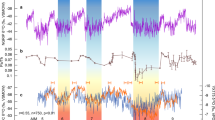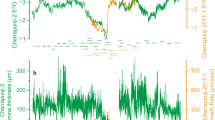Abstract
During the last glacial period, large millennial-scale temperature oscillations—the ‘Dansgaard/Oeschger’ cycles—were the primary climate signal in Northern Hemisphere climate archives from the high latitudes to the tropics1,2,3,4,5,6. But whether the influence of these abrupt climate changes extended to the tropical and subtropical Southern Hemisphere, where changes in insolation are thought to be the main direct forcing of climate, has remained unclear. Here we present a high-resolution oxygen isotope record of a U/Th-dated stalagmite from subtropical southern Brazil, covering the past 116,200 years. The oxygen isotope signature varies with shifts in the source region and amount of rainfall in the area, and hence records changes in atmospheric circulation and convective intensity over South America. We find that these variations in rainfall source and amount are primarily driven by summer solar radiation, which is controlled by the Earth's precessional cycle. The Dansgaard/Oeschger cycles can be detected in our record and therefore we confirm that they also affect the tropical hydrological cycle, but that in southern subtropical Brazil, millennial-scale climate changes are not as dominant as they are in the Northern Hemisphere.
This is a preview of subscription content, access via your institution
Access options
Subscribe to this journal
Receive 51 print issues and online access
$199.00 per year
only $3.90 per issue
Buy this article
- Purchase on Springer Link
- Instant access to full article PDF
Prices may be subject to local taxes which are calculated during checkout


Similar content being viewed by others
References
Dansgaard, W. et al. Evidence for general instability of past climate from a 250-kyr ice-core record. Nature 364, 218–220 (1993)
Peterson, L. C. et al. Rapid changes in the hydrologic cycle of the tropical Atlantic during the Last Glacial. Science 290, 1947–1951 (2000)
Schulz, H., von Rad, U. & Erlenkeuser, H. Correlation between Arabian Sea and Greenland climate oscillations of the past 110,000 years. Nature 393, 54–57 (1998)
Allen, J. R. M. et al. Rapid environmental changes in southern Europe during the last glacial period. Nature 400, 740–743 (1999)
Burns, S. J., Fleitmann, D., Kramers, J., Matter, A. & Al-Subbary, A. Indian Ocean climate during the last glacial period and an absolute chronology for Dansgaard/Oeschger oscillations 9 to 13. Science 301, 1365–1367 (2003)
Wang, Y. J. et al. A high-resolution absolute-dated late Pleistocene monsoon record from Hulu Cave, China. Science 294, 2345–2348 (2001)
Vera, C. S., Vigliarolo, P. K. & Berbery, E. H. Cold season synoptic-scale waves over subtropical South America. Mon. Weath. Rev. 130, 684–699 (2002)
Zhou, J. & Lau, K. M. Does a monsoon climate exist over South America? J. Clim. 11, 1020–1040 (1998)
Gan, M. A., Kousky, V. E. & Ropelewski, C. F. The South American monsoon circulation and its relationship to rainfall over West-Central Brazil. J. Clim. 17, 47–66 (2004)
Rao, V. B., Cavalcanti, I. F. A. & Hada, K. Annual variation of rainfall over Brazil and water vapor characteristics over South America. J. Geophys. Res. 101, 26539–26551 (1996)
IAEA/WMO. Global Network for Isotopes in Precipitation (GNIP) Database (IGBP PAGES/World Data Center-A for Paleoclimatology Data Contribution Series 94–005 NOAA/NGDC Paleoclimatology Program, Boulder, Colorado, 1994); http://isohis.iaea.org
Rozanski, K., Araguás-Araguás, L. L. & Gonfiantini, R. in Climate Change in Continental Isotopic Records (eds Swart, P. K., Lohmann, K. C., McKenzie, J. & Savin, S.) 1–36 (Geophysical Monograph 78, American Geophysical Union, Washington, DC, 1993)
Hendy, C. H. The isotopic geochemistry of speleothems. I. The calculation of the effects of different modes of formation on the isotopic composition of speleothems and their applicability as paleoclimatic indicators. Geochim. Cosmochim. Acta 35, 801–824 (1971)
Friedman, I. & O'Neil, J. R. In Data of Geochemistry (ed. Fleischer, E. M.) Ch. KK, 1–12 (United States Geological Survey Professional Paper 440-KK, US Government Printing Office, Washington, DC, 1977)
Stute, M. et al. Cooling of tropical Brazil (5 °C) during the last glacial maximum. Science 269, 379–383 (1995)
Lea, D., Pak, D. K., Peterson, L. C. & Hughen, K. A. Synchroneity of tropical and high latitude temperature over the last glacial termination. Science 301, 1361–1364 (2003)
Berger, A. & Loutre, M. F. Insolation values for the climate of the last 10 million years. Quat. Sci. Rev. 10, 297–317 (1991)
Nogués-Paegle, J. & Mo, K. C. Alternating wet and dry conditions over South America during summer. Mon. Weath. Rev 125, 279–291 (1997)
Gat, J. R. Oxygen and hydrogen isotopes in the hydrologic cycle. Annu. Rev. Earth Planet. Sci. 24, 225–262 (1996)
Vuille, M., Bradley, R. S., Werner, M., Healy, R. & Keimig, F. Modeling δ18O in precipitation over the tropical Americas: 1. Interannual variability and climatic controls. J. Geophys. Res. 108, 4174, doi:10.1029/2001JD002038 (2003)
Behling, H. South and Southeast Brazilian grasslands during Late Quaternary times: a synthesis. Palaeogeogr. Palaeoclim. Palaeoecol. 177, 19–27 (2002)
Mayle, F. E., Burbridge, R. & Killeen, T. J. Millennial-scale dynamics of southern Amazonian rain forests. Science 290, 2291–2294 (2000)
Baker, P. A. et al. The history of South American tropical precipitation for the past 25,000 years. Science 291, 640–643 (2001)
Seltzer, G., Rodbell, D. & Burns, S. J. Isotopic evidence for Late Glacial and Holocene hydrologic change in tropical South America. Geology 28, 35–38 (2000)
Brook, E. J., Sowers, T. & Orchardo, J. Rapid variations in atmospheric methane concentration during the past 110,000 years. Science 273, 1087–1091 (1996)
Maslin, M. A. & Burns, S. J. Reconstruction of the Amazon Basin effective moisture availability over the past 14,000 years. Science 290, 2285–2287 (2000)
Schrag, D. et al. The oxygen isotopic composition of seawater during the Last Glacial Maximum. Quat. Sci. Rev. 21, 331–342 (2002)
Chiang, J. C. H., Biasutti, M. & Battisti, D. S. Sensitivity of the Atlantic Intertropical Convergence Zone to the Last Glacial Maximum boundary conditions. Paleoceanography 18(4), 1094, doi: 10.1029/2003PA000916 (2003)
North Greenland Ice Core Project members. High resolution record of Northern Hemisphere climate extending into the last interglacial period. Nature 431, 147–151 (2004)
Sharp, W. D., Ludwig, K. R., Chadwick, O. A., Amundson, R. & Glaser, L. L. Dating fluvial terraces by 230Th/U on pedogenic carbonate, Wind River Basin, Wyoming. Quat. Res. 59, 139–150 (2003)
Acknowledgements
We thank the Fundação de Amparo a Pesquisa do Estado de São Paulo (FAPESP) for financial support, the CECAV/IBAMA for authorizing cave samples collection and the GEEP-Açungui Speleological Group and E. Barni for supporting field work.
Author information
Authors and Affiliations
Corresponding author
Ethics declarations
Competing interests
The authors declare that they have no competing financial interests.
Supplementary information
Supplementary Figures S1-S4
This file contains four Supplementary Figures. Supplementary Figure S1 shows precipitation patterns for winter and summer in Brazil and Supplementary Figure S2 the mean monthly rainfall and oxygen isotope ratios for rainfall for southern Brazil. Supplementary Figure S3 details the carbon and oxygen isotope data for stalagmite BT2 that test for kinetic isotope effects and Supplementary Figure S4 spectral analyses of the BT2 oxygen isotope time series. (DOC 238 kb)
Supplementary Table S1
This file contains a Supplementary Table of Uranium and Thorium isotope data for stalagmite BT2. (PDF 39 kb)
Rights and permissions
About this article
Cite this article
Cruz, F., Burns, S., Karmann, I. et al. Insolation-driven changes in atmospheric circulation over the past 116,000 years in subtropical Brazil. Nature 434, 63–66 (2005). https://doi.org/10.1038/nature03365
Received:
Accepted:
Issue Date:
DOI: https://doi.org/10.1038/nature03365
This article is cited by
-
Humid and cold forest connections in South America between the eastern Andes and the southern Atlantic coast during the LGM
Scientific Reports (2024)
-
Changes in the South American Monsoon System components since the Last Glacial Maximum: a TraCE-21k perspective
Climate Dynamics (2024)
-
Influence of early/mid-Holocene climate change and sea level rise on a coast with barrier islands, Rio de Janeiro State, SE Brazil
Journal of Sedimentary Environments (2024)
-
The PaleoJump database for abrupt transitions in past climates
Scientific Reports (2023)
-
Summer insolation controlled movements of Intertropical Convergence Zone during last glacial cycle in northern South America
Communications Earth & Environment (2023)
Comments
By submitting a comment you agree to abide by our Terms and Community Guidelines. If you find something abusive or that does not comply with our terms or guidelines please flag it as inappropriate.



